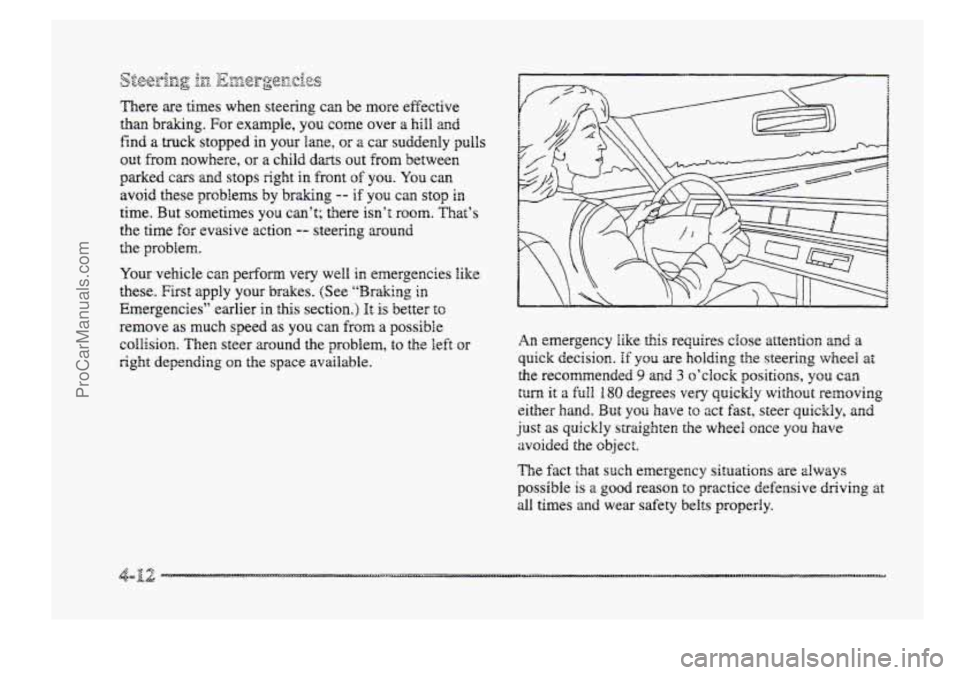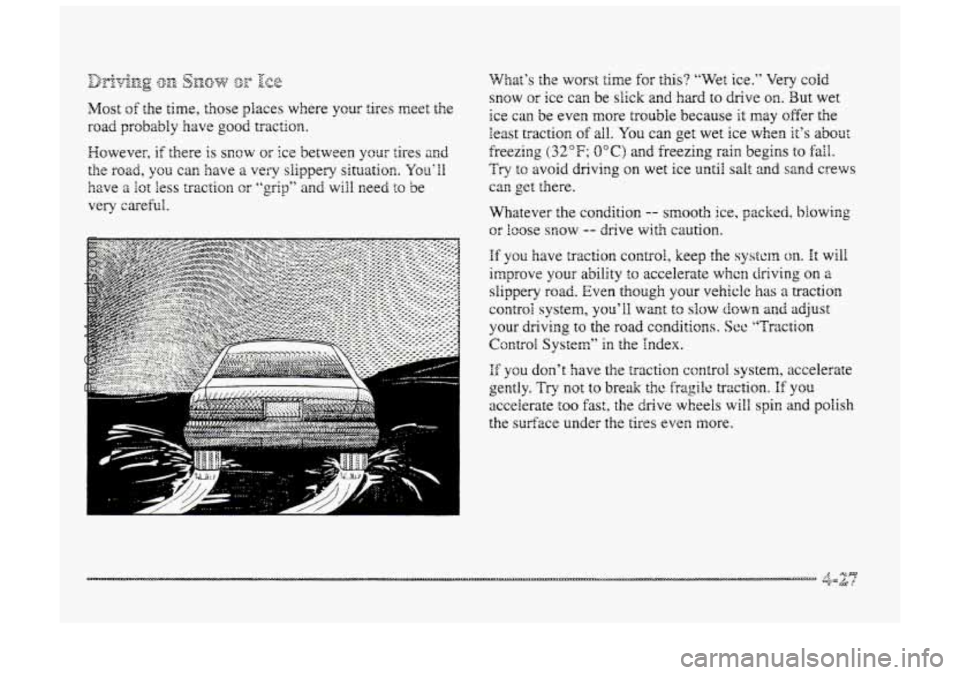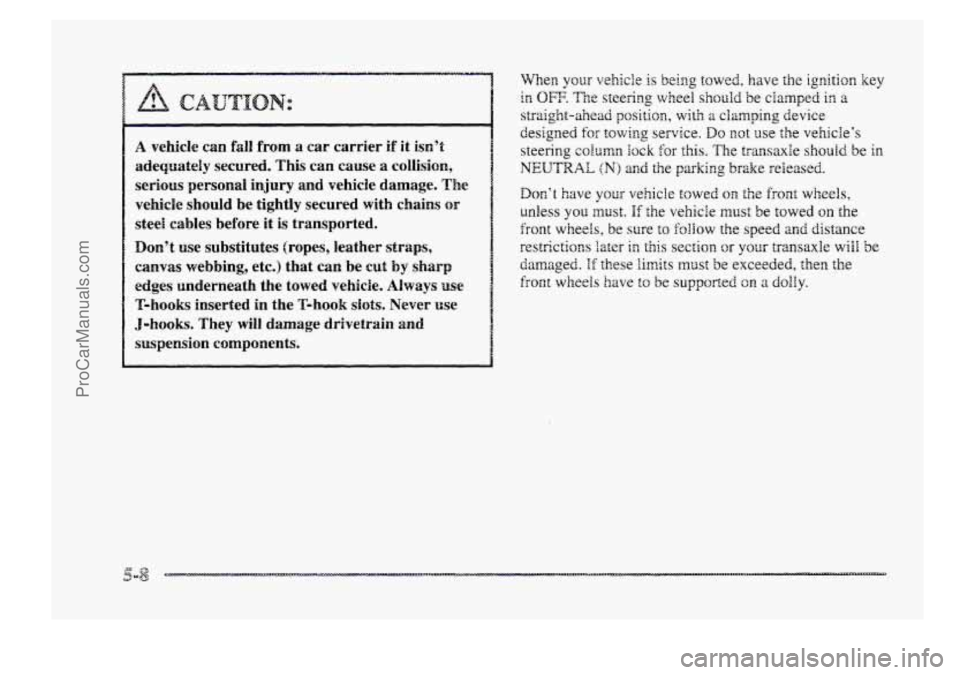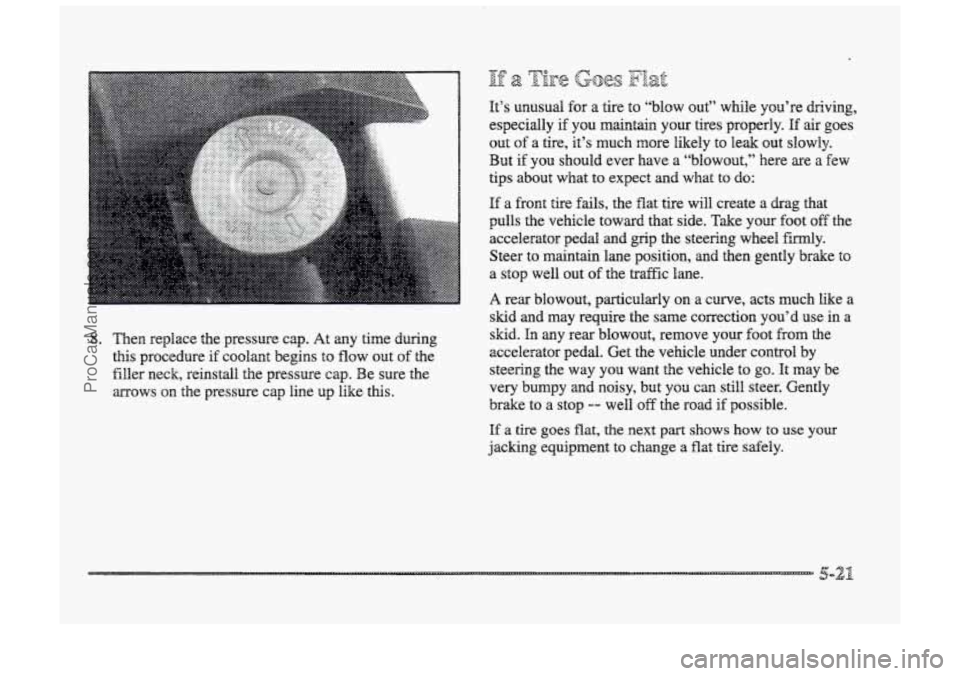Page 212 of 426
To turn the system off, press the button l~cated at the
end of the shift lever.
The traction control system warning light will come on
and stay on. If the system is limiting wheel spin when
you press the button, the warning light will come
on -- but the system won’t turn off right away.
It will wait until there’s no longer a current need to hit
wheel spin.
Ym can turn the system back on at any time by pressing
?.he button again. The traction control system warning
Bi& xkcPetM go off.
Your vehicle may be equipped with GM Magnasteer ” ,
a steering system that continuousIy adjusts the effort you
feel when steering at all vehicle speeds. It provides ease
when parking yet a firm, solid feel at highway speeds.
You- steering can be adjusted for an easier or more firm
setting. See your dealer for information
ProCarManuals.com
Page 213 of 426
It‘s important to take curves at ;r reasonable speed.
A lot of the “driver lost control” accidents mentioned on
the news happen on curves. Here’s why:
Experienced driver or beginner, each of us is subject to
the same laws of physics when driving on curves. The
traction of the tires agzjinst the roaC surface makes it
possible fcr the vehicle to change its path when you turn
the front wheels. If there’s no traction, inertia wiHl keep
the vehicle going in
the same direction. If you‘ve ever
tried
to steer a vehicle on wet ice, YQK‘IB understacd this.
The
trzctionr YOU can get in a curve depends on the
condition of your tires md the road surface, the angle at
which Gie curve
is banked, and your speed. Mile you’re
in ip curve, speed is the one fxtor you can control.
Suppose ycu’re steering through a sharp curve.
Then you suddenly accelerate. Both control
ProCarManuals.com
Page 214 of 426

&3g;-izg 1x1 0 &i&rpe[z.iQs 7,ww e?
There are times when steering can be more effective
than brakmg. For example, you come over a hill and
find a truck stopped in your lane, or a car suddenly pulls
out from nowhere, OH a child darts out from between
parked
cars md stops right in front of YOU. You can
avoid these problems by
braking -- if you can stop in
time. But sometimes you can’t; trlere isn’t room. That’s
the time
for evasive action -- steering ~ound
the problem.
Your vehicle can perform very well in emergencies like
these. First apply your brakes. (See ‘‘Braking in
Emergencies” earlier in ”s section.) It is better tc
remove as much speed as you can from a possible
collision. Then steer around the problem, to the left or
right depending on the space available.
An emergency like this requires close attention and a
quick decision. If you are holding the steering wheel a’:
the recomended 9 and 3 o’clock positloas, you can
tuna it a full 180 degrees very quickly without removing
either hand. But you have to act fast, steer quickly, and
just as quickly straighten the wheel once you have
avoided the
object.
The fact that such emergency situations are always
possible is a good reason to practice defensive driving at
dl times and wear safety belts properly.
ProCarManuals.com
Page 226 of 426
]Is there actually such a ~~nrdition as “highway
hypnosis”? Or is it just plain falling asleep at the wheel?
Call it highway hypnosis, lack of awareness,
or whatever.
mere
is something about an easy stretch of road with
the same scenery, dong with the hum of the tires on the
road, the &one
of the engine, and the msh of the wind
against the vehicle
that can make you sleepy. Don’t let it
happen to you! If it does, your vehicle can leave the
road in less than a secondy and you could crash agld
be injured.
@ Keep YQW eyes moving. Scan the road ahead and to
the sides. Check YOLK rearview ~~II-QI-S and your
instruments frequently.
@ If you get sleepy, pull off the road into a rest, service
or parking area and take a nap, get some exercise, or
both. For safety, treat drowsiness on the highway as
an emergency.
ProCarManuals.com
Page 229 of 426

However, if there is snow OF ice between yorar tires and
the road, you can have a very slippery situation. You’ll
have a lot less traction cr “grip” and will need to be
very careful.
..........
..-- ... .. ‘ _._ , .....
What’s the worst time for this? “Wet ice.” Very cold
snow or ice can be slick 2nd hard to drive on. 3ut wet
ice can be even more trouble because
it may oEer the
least traction of all. You can get wet ice when it’s about
freezing
(,32”F; OOC) and freezing rain begins to fail.
Try to avoid driving on wet ice until salt 2nd sand crews
can get there.
Whatever the condition
-- smooth ice, packed, blowing
or hose snow -- drive with caution.
If you have traction control, keep the systcrn on. It will
improve your ability
to accelerate when driving on a
slippery road. Even though your vehicle has a traction
controi system,
you’ll want to slow down and adjust
your driving to the road conditions. Sec ‘‘Trrrctionr
Control
System” in the Index.
If you don’t have the traction control system, accelerate
gently.
Try not to break thc FragiEt: Fraction. If you
acceierate too fast, the drive wheels will spin and polish
the surface under the tires even more.
ProCarManuals.com
Page 235 of 426
Eszd-pulling components such as the engine, transaxle.
wheel assembiles and tires %e forced ea work harder
against the drag uf the added weight. The engine is
required to operate at reEativeIy higher speeds and gnder
grczter Isads, gecerating extra heat. What's more, the
trailer adds considerably to wid resistance, increasing
the pulling requirements.
If You Do Decide To PnlI A Railerr
If you do, here are some irqm-tana points:
There
are mmy different laws, inclndlng speed Zimit
restrictions, having to do with trailerkg Make sure
your
rig will be legal, not only where yolr live but
also where you'll be driving. A good source for this
infomation can be state or' provincial peke.
ProCarManuals.com
Page 248 of 426

2
A vehicle can fall from a car carrier if it isn’t
adequately secured. This can cause a collision,
serious personal injury and vehicle damage. The
vehicle should be tightly secured with chains OF
steel cables before it is transported.
Don’t use substitutes (ropes, leather straps,
canvas webbing, etc.) that can be cut by sharp
edges underneath the towed vehicje. Always use
T-hooks inserted in the T-hook siob. Never use
J-hooks. They will damage drivetrain and
suspension components. When your vehicle
is being towed, have the ignition key
in OW. The steering wheel should be
clamped in a.
straight-ahead position, with a clamping device
designed for towing service. DQ not use the vehicle’s
steering
column iock for this. The transaxle should be in
NEUTRAL (N) and the parking brake released.
Don’t have your vehicle towed the front wheels,
unless you must. If the vehicle must be towed QII the
front wheels, be sure to fallow the speed and distance
restrictions later in this section or your transaxle will be
damaged. If these Limits must be exceeded, then the
front wheels have to be supported on a dolly.
ProCarManuals.com
Page 261 of 426

0:. .. . .
If 8 Goes FE&
It’s unusual for a tire to “blow out” while you’re driving,
especially
if you maintain your tires properly. If air goes
i...
...
out of a &e, it’s much moie likely to leak out slowly.
But if you should ever have a “blowout,” here are
a few
tips about what to expect
and what to do: 1 ‘i
< 1 If a front tire fails, the flat tire will create a drag that
’, !! pulls the vehicle toward that side. Take YOLK foot off the g accelerator pedal and grip the steering wheel firmly.
P Steer to maintain lane position, and then gently brake to
-4 ,i a stop well out of the traffic lane.
.2? .
A rear blowout, particularly on a cwe, acts much like a
skid and may require the same correction you’d use in a
8. Then replace the pressure cap. At any time during
this procedure if
CQQ~EUI~ begins to flow out of the
filler neck, reinstall the pressure cap. Be sure the
mows
on the pressure cap line up like this.
s~. h any kearblowout, remove your foot kom the
accelerator pedal. Get the vehicle under control by
steering the
way you want the vehicle to go. It may be
very bumpy and noisy, but you can still steer. Gently
brake to
a stop -- well off the road if possible.
If a tire goes flat, the next part shows how to use your
jacking equipment to change a flat
tire safely.
ProCarManuals.com